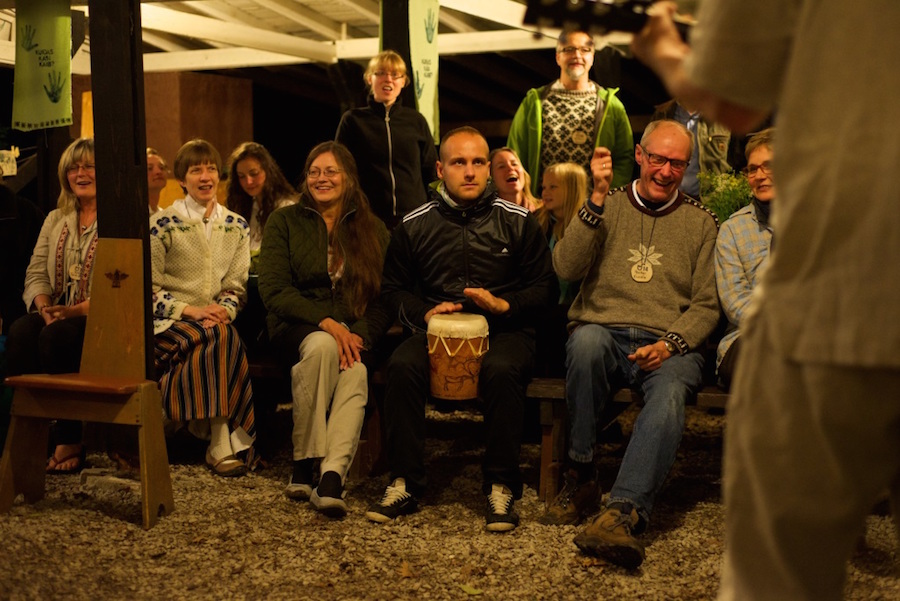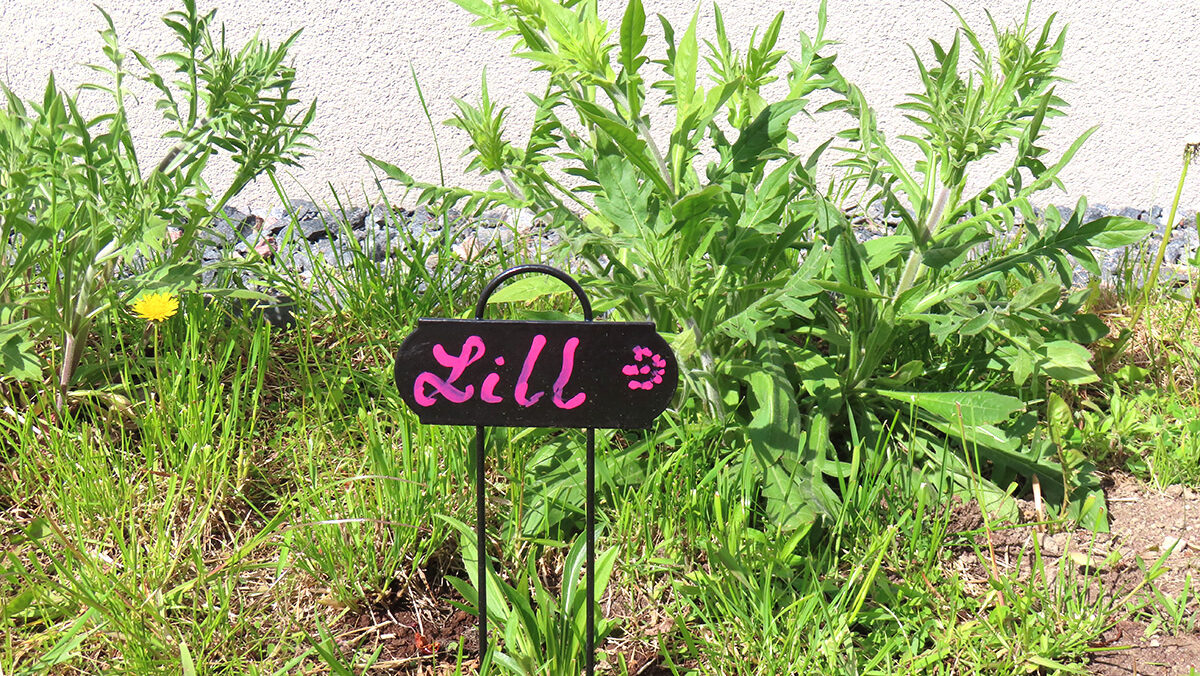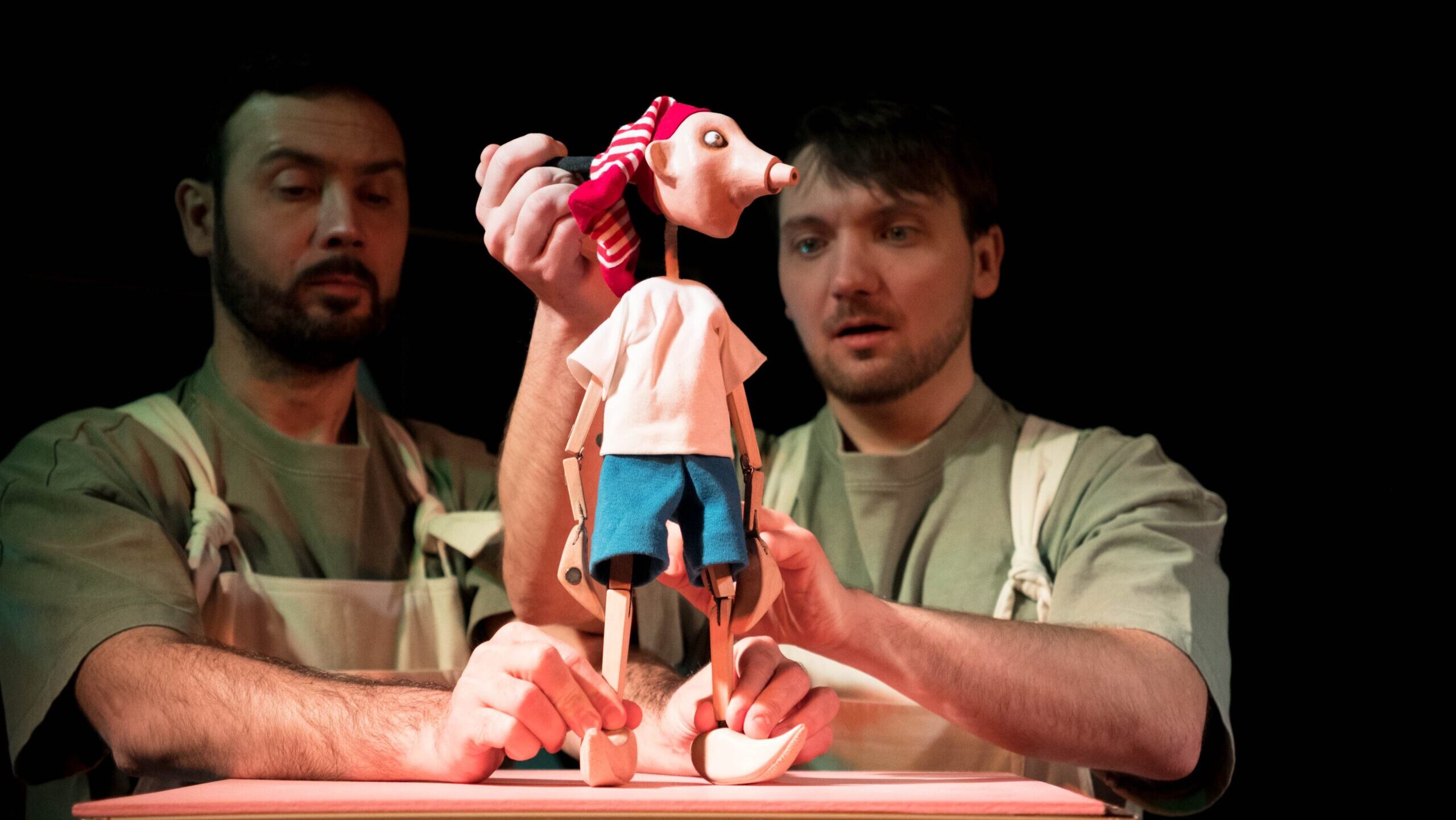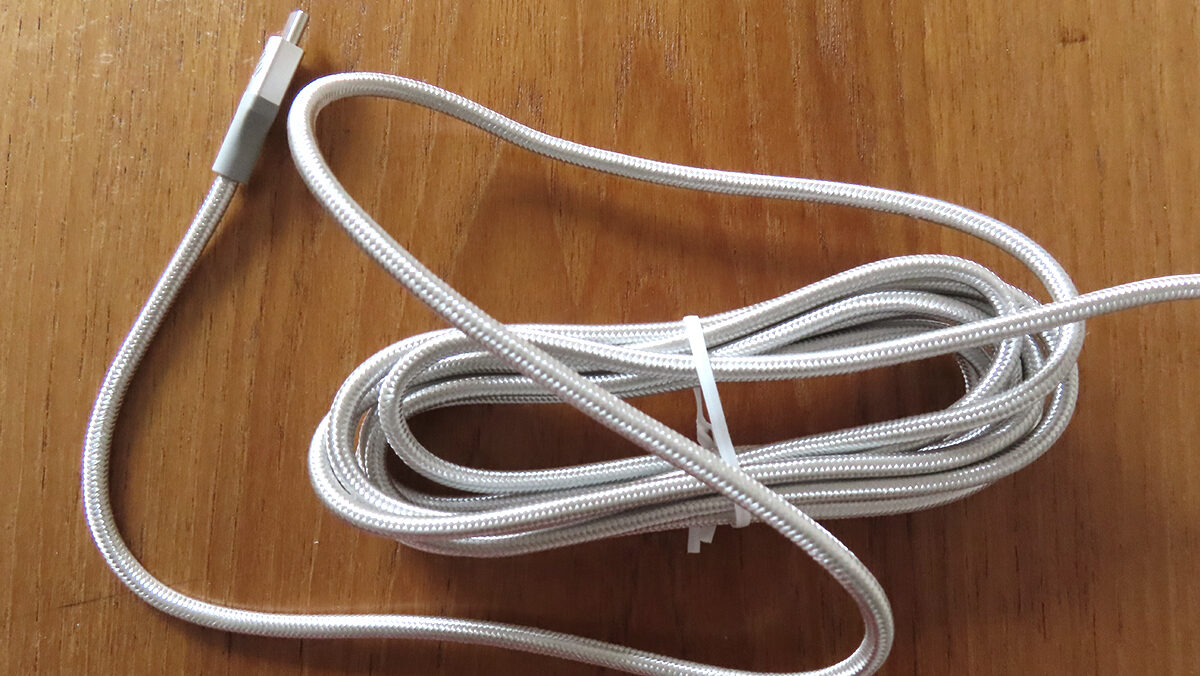Metsaülikool means “forest university”. People of Estonian heritage have been coming here since 1967 to reconnect with their roots at this total immersion cultural camp in the deep woods of Canada, about two hours' drive north of Toronto.
I rushed upstairs to the “peamaja” (main house) sleeping loft that would be home for the next week and quickly got into my bathing suit, grabbed a towel and hurried down to meet Sirje. As we walked companionably down the wooded path to the lake, I felt the hectic, electronic world we're bound to so tightly every day slowly start to relax its hold.
“The water is like silk,” sighed Sirje as we slid into the smooth, glassy water. With every stroke, we began to assimilate into the remarkable week we would have here.
Sirje is a noted author, born in Estonia, who now lives in South Dakota. She is also a swimming fanatic and goes for several rejuvenating dips per day, rain or shine. Being in her orbit for the week is an absolutely essential part of my MÜ experience. Each year she picks a theme for her main lecture and daily study group – this year it is “romance and sex in Estonian literature”. Really! Who knew?
Being at MÜ – a week-long camp on 425 acres of pristine land in Ontario's Muskoka region owned by the Estonian Scouts Sponsors'Association – is like being in another country. Your country. MÜ-goers are from all age ranges and may have one or both parents who are Estonian. They come from Canada, the United States, Australia, New Zealand, France and yes, even Estonia.
The name “Metsaülikool,” however, is a bit of a misnomer, explains Maimu Mölder, the MÜ coordinator and the “glue” that holds this annual event together. “The lectures are usually along the lines of a TEDX talk, not overly complicated, and you certainly don't need a university degree to come to MÜ,” she says. “It really is designed to be accessible and easy to follow.”
MÜ is further strengthened by a core group of dedicated volunteers who put together the program, source and host the speakers and plan the many activities.
On the “learning” side, the week consists of twice-daily lectures and daily study and language groups. For recreation, there is swimming, a daily folk-dancing class with an enthusiastic young teacher who comes to us from Estonia, canoeing, campfires and a highly spirited wrap-up party on the last night.
Naturally there is also the rejuvenating sauna, easily the most popular and picturesque building on the property, perched as it is on the edge of Kotkajärve's private lake and accessed via a meandering trail through the forest. Our “saunamees” – or sauna dude – looks after stoking the fire and coaxing the temperature to the appropriate spirit-scorching temperature. It is sheer heaven to breathe in the smoky wood scent of the sauna while sweating out life's impurities and then taking several bracing plunges into the lake.
But being at MÜ is much more than speakers, singing and sauna. The overall effect of being here is deeply spiritual for many people. It's like all the things I struggle with all year seem to find a solution here – my spirit is strengthened through the energy of the people and my own ability to stretch what I know and what I think is possible. Things, quite simply, start to make sense.
Because as much as we assimilate into the culture in which we're born, there is always a part of us that is intrinsically, unabashedly and permanently Estonian. I was born in Toronto and grew up in the Estonian community here. I couldn't be more Canadian, but coming to MÜ helps close some kind of circle that has remained open and perplexed me my entire life.
Is it possible to have a strong allegiance to two cultures? I think it is, and I am lucky enough to live in a country where it is possible to have both. This week, dedicated to exploring and learning more about the culture of the blood that runs in my veins, is a precious gift.
After Sirje and I have our inaugural swim, MÜ starts with dinner, an evening lecture and a get-acquainted gathering. The week ahead would prove to be exhilarating, surprising, emotional, unexpected and utterly satisfying.
MÜ's theme this year was “terve vaim, terve rahvas” (“healthy spirit, healthy people”). Finally, I thought, Estonians are going to talk about their feelings! This would be great, and it was.
I cannot stress enough how jaw-droppingly interesting the lectures are. As we settled into our chairs at the beginning of a lecture, it always hits me hard how incredible the people are who come here and share what they do and what they know.
Those who work every day in English painstakingly translate their material into Estonian and apologise that it's not perfect. This is what I mean about the magic of MÜ – it is full of humble and remarkable people who come here on their own time to enlighten and inspire.

There were many memorable moments. Here are snapshots of some of the lecturers at this year's MÜ.
Ragne Pajo, psychologist. When Ragne first moved from Estonia to the United States, she couldn't believe how people left their curtains open at night. In Estonia, everyone draws them tight when darkness falls. Ragne, who is a psychologist and clinician at the Clifford Beers Clinic in New Haven, Connecticut, says that this speaks volumes about the Estonian psyche.
“Half of Estonians were directly affected by escaping during the war, and the other half saw it,” she explained. This can result in post-traumatic stress disorder and a host of accompanying symptoms. These can include fear, anxiety, hyper-vigilance, nightmares, flashbacks and depression.
We learned that some people are more resilient and don't have any of these symptoms, or are affected to a lesser degree. Others may cope by turning to alcohol, becoming introverted and having suicidal thoughts.
She explained that we can cope with these feelings through faith, love of our homeland, involvement in the arts and culture and making the best of what we have. Post-traumatic stress disorder of the type that Estonians experienced during their displacement and occupation during World War II can last two to three generations, she said. For us, that means the effects will be felt until 2040. I realise that for me, that will likely be until very close to the end of my life.
Ragne advises that talking through the trauma experienced by our families and ourselves helps bring peace and closure. “If it's a secret, the aggressor still has the power,” she says. Ragne's talk led me to ponder another question that's been circling in my brain for a long time. How much should we re-live the past and how can we look to the future with a full and happy heart?
I catch up with Ragne later and pose the question. Turns out, it is all connected. “To understand the present, look to the past,” she says. “Then you are able to move toward the future.” I understand, and it helps. Looking at the past has its place.
Jaak Rakfeldt, psychologist. Jaak is a professor at the South Connecticut State University and an expert on cognitive dialectical therapy. He is also an assistant clinical professor at the Yale University School of Medicine, Department of Psychiatry.
What this means is that he knows how people tick, why and how they struggle and what it takes to get them back on track. “Negative thoughts and negative emotions affect the body,” he says. Letting go of these patterns can take time, but the results are worth it.
History has moulded the Estonian temperament because we have lived under difficult conditions for a long time. Many of us learned to over control our emotions as a coping mechanism, but this can “end badly”, he says. “We need to learn how to open up.”
The type of therapy that Jaak practices helps people turn their thinking around and change behaviour. Being flexible and working toward change is a key component of achieving good mental health. “How do you picture yourself walking, talking, being?” he asks. “Remember, you're in charge.”
Other ways to change your behaviour and thought patterns is to have a plan. For example, if alcohol is a problem, figure out what you're going to do when you go to an event where drinks will be served. Deciding in advance that you won't drink, or that you'll limit yourself to just one, helps change behaviour.
Jaak is a longtime friend of MÜ, but hadn't been back here for 15 years. He's embarking on plans for a new research project to help people in Estonia deal with their past so they can live full and prosperous lives. He has promised to keep us posted. “Life began to change for me when I came here in the '70s,” he said. “Now, I want to give back. We sincerely hope that he comes back.
Mihkel Raud, TV host, journalist and musician. Mihkel Raud may be best known for his rock band Singer Vinger and his many TV credits, but this thoughtful and introspective man counts one of his most important milestones the fact that he had his last drink in 1990.
“I drank full time from age 16 to 20,” he said. “It was a good time being drunk – and very much a part of the rock music world.” But something made him realise he couldn't do this forever and he stopped drinking on the spot.
Mihkel came to MÜ this year from Estonia as a lecturer and told his story openly and candidly as a contribution to the “healthy spirit, healthy people” theme. He says he still suffers from the aftermath of his alcoholism and struggles with fear and anxiety.
“Estonians don't know a lot about the issue of alcoholism,” he said. “People think drinking gives them courage. It's an escape from who you are. More talking and attention is needed.”
In the 29 August issue of Toronto's weekly Estonian newspaper, Eesti Elu, Mihkel also said that coming to MÜ was almost a religious experience for him and one he did not expect to have on the other side of the Atlantic Ocean. He said he regained an even stronger sense of national pride being with us, and was extremely grateful for this incredible journey into his own soul.
Mihkel, who is the son of writers Eno Raud and Aino Pervik, is an accomplished journalist, author and television personality. He is now turning his energies to politics and is running in the next Estonian election as a social democrat.
Armas Maiste, musician. Armas Maiste is 85 years old and has not lost one iota of his charisma as a performer. A jazz and classical pianist, Armas had us enthralled for an hour and a half with his witty talk about what piano playing and flying have in common.
To him, a piano and a flight simulator are equally fascinating and studying both keeps his obviously nimble brain active. A conductor is like an air traffic controller, he said. An extremely good memory and discipline is needed for both pursuits.
He told us how, during the German occupation of Estonia, when he was just 12 years old, he was invited onto a plane by a German solider to look at the cockpit. The dials, gauges and control panel had him hooked at once. Thus began a lifelong fascination with the world of aviation.
Armas went on to have a stellar career as a pianist. He played for both the Montreal Symphony Orchestra and Les Grand Ballets Canadiens. He told me later he loved playing for the ballet company in particular because of their varied and interesting programming and music.
I also asked him how he got to be so funny. He said he played in comedy clubs in Montreal for 28 years and learned his comic delivery and timing from the comedians who performed there. Armas means “beloved”. The name fits this exceptional man perfectly.
Elin Toona, author. Elin Toona left Estonia in a crowded fishing boat with her mother and grandmother in 1944 to escape advancing Soviet tanks. She was seven years old. She said her last vision of the country where she was born was of a sandy shore strewn with suitcases. A black cat sat on a cabinet that had been left on the beach, licking its paw. It reminded her of the pet they had to leave behind. “Our cat Tondu didn't say goodbye,” she said. “He knew we weren't coming back.”
Elin's life would take many twists and turns after she got off that boat in Germany. Her Estonian all but disappeared as she made a life for herself there, then in England and the United States. As an 11 year-old child in England, the state put her in an orphanage because the space they had at home was deemed inadequate. She wasn't allowed to see her family for nine months and, after that, only on Sundays.
At the age of 15, she had to work in a textile factory in Yorkshire – refugees were denied higher education – where her day began at 4.30 am. When she was older, she moved to London and started her writing career in English, all the while struggling to understand her past and find her identity in a class-conscious, post-war society.
Despite almost losing her ability to speak and write in Estonian, Elin regained her mother tongue and went on to write seven books in Estonian. She recently published an English book titled “Into Exile: A Life Story of War and Peace”.
Her writing and story-telling style is clear and utterly compelling. “I am the same Estonian who left my country at age seven,” she said.
Hands down one of my favourite activities during the week is the night-time visit to the “hiis”, or holy grove on the Kotkajarve grounds. Led by grove elder Margus Tae, this is a spiritual tradition that takes place at every MÜ.
The visit to the holy grove is a chance to reconnect with our Estonian ancestors, who revered nature. As we file silently along a mossy path to the site of the “hiis”, flashlights bobbing in the darkness, a quiet and profound stillness engulfs us. Margus is waiting at the end of the path where a small fire burns on a rocky outcropping.
All we hear is the sighing of the wind in the trees and the crackle of the fire. No one speaks. Margus explains how the generations who came before us would visit a “hiis” to connect with the powerful force that is the natural world and to gain strength from it.
Margus tells me later that there are 700 such spots in Estonia, and that the locations are passed down through the generations. Families often go to these sacred spots – even taking a picnic – to connect and spend time with their departed ancestors.
“If you believe, you can find peace here,” Margus says. This makes perfect sense to me. Connecting with my ancestors and spiritual traditions in the simple sanctuary of nature is something I connected to immediately the first time I came here.
Another poignant moment was the commemoration of the 70th anniversary of the escape from their homeland by many Estonians. It was in 1944 that so many of our relatives and loved ones left all they knew and all they owned behind to escape the Soviet invasion.
Longtime MÜ volunteer Tiia Remmelkoor coordinated this evening. She presented a painstakingly assembled slide show of images culled from the Estonian archives in Toronto by librarian Alliki Arro of refugees and the temporary communities they had set up in “displaced persons” camps in Germany. Many refugees went to Germany from Estonia.
I had heard stories of these camps from my parents and grandparents, who lived in them, but had never seen any photos. It was very moving to see how people who had nothing but scattered memories and whatever mementoes they had been able to bring with them build up a sense of community and carry on. Another piece of the puzzle had fallen into place for many of us after seeing these images.
Here we've been surrounded by nature. The natural world welcomed us and made room for our footsteps. It will sustain us over the coming months as we hurtle back down the highway to the cities and towns where we live.
If only we knew that the very thing we try so hard to control, to push out of our lives so that other seemingly urgent things can be attended to – this is what truly makes us whole.
In their own words: How does MÜ help strengthen your spirit?
Ingel Undusk (Musician and poet from Tallinn, Estonia, led MÜ study group). “This is my third year here, and it has been a deep experience for me. The community here has opened its heart and are very receptive to what I have to offer. You can connect with your deepest self here.”
Tiina Hiis and Hans-Ashton Soots (Toronto, Ontario, Canada). Tiina: “This has been one of my favourite themes. I can really relate to it. We're so immersed in the world of electronics every day – it's important to take the time to be in nature and ground yourself, re-energise and regenerate. Everything here is so alive around us – we forget about that when we live in the city.”
Hans-Ashton: “It's a week in the year where I know I won't have any distractions, where I can reflect on what has happened and what's coming. We've learned this year how our actions are fueled by our emotions – when you're here, you get to re-set those emotions.”
Jaak Rakfeldt (New Haven, Connecticut, the US). “A healthy spirit is utterly essential for grappling with life. It's what makes us healthy. MÜ is holistic on all levels and helps us to achieve that – it's a whole week with vibrant, talented, interesting people. It's an enriching experience where you develop lifelong friendships.”
Indrek Wichman (Okemos, Michigan, the US). “Sometimes we want something deeper, more meaningful than the usual hum-drum of daily life in a world where discussions are often shallow and superficial. In the massive “tossed salad” that is modern North America, it is almost necessary to anchor oneself in a smaller, tighter world where history, culture, art and kinship can fill the void. Being here with my own ‘tribe' is very fulfilling.”
Anu Grabbi (Washington, DC, the US). “This was my first year at MÜ. The experience reveals itself layer by layer as the week goes on and you go deeper and deeper – the true, good Estonian spirit is here.”
Erik Kõvamees (Vancouver, British Columbia, Canada). “In one week, you can learn an incredible amount about Estonian culture. It really broadens your horizons and leaves a lot of lasting impressions. It helps me understand what it is to be Estonian.”
Elva Mikk (Rochester, New York, the US). “This is my tenth year at MÜ. It gives you more depth, you understand your roots better and explore your culture. I get so many insights from the people here and whole new worlds open up in the study groups.”
Karin Ivand, Estonian World, Life, December 2014




